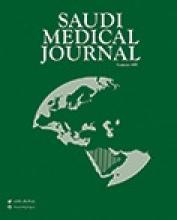To the Editor
Nesfatin is a potent anorectic neuropeptide which plays an important role in food intake and energy expenditure.1,2 It has been linked to depression and coronary plaque.1,2 While galatin is neuropeptide which is widely expressed in the brain and hypothalamus. Both neuropeptides play an important role in regulation of energy balance and modulation of food intake. Thus, the concept of having these neurotransmitters as biomarkers for metabolic syndrome is logic. It was very interesting to find a relationship of these biomarkers and the metabolic syndrome. It’s noteworthy that as compared to counterpart healthy controls, the individuals in the metabolic syndrome group were taller, and heavier, but there was no statistical significant difference in the body mass index (BMI). This stresses on the importance of the components of metabolic syndrome which make certain individuals at risk. However, there are several drawbacks of the study. Firstly, the sample size is small which decreases the statistical power. There is no clear matching point between the 2 group, although the age was a fortuitous match. Furthermore, there was no control for the confounding variables. For example, the individuals in the metabolic syndrome group were in diabetes range ( mean HbA1c 7.69 and mean fasting blood glucose is 8.8 mmol/L). So, the results can be challenged and attributed to diabetes mellitus rather than metabolic syndrome.
In conclusion, it is always good to find new biomarkers for metabolic disease which might help us in understanding the pathogenesis of these diseases and might guide to new innovations in the future management.
Reply from the Author
We would like to thank you for your critiques and revision recommendations. In future work, we will focus on those research issues we mentioned before. According to our unpublished data we found that by using the multiple backward regression analysis to determine significant confounding factors for serum nesfatin-1 and galanin levels (as dependent variable). When multiple regression analysis was performed to determine which variables were independently associated with serum nesfatin-1 levels, waist circumference remained significant while that fasting blood glucose were independent determinants of serum galanin levels.
Association of serum galanin level with components of metabolic syndrome
Multiple backward linear regression analysis of the variables showed that only fasting blood glucose (β=0.38, p=0.002) was considered to be independent predictor of serum galanin level and explained approximately 12% (R2=0.12) of the whole variance (Table 1).
Multiple backward linear regression using serum galanin concentration as dependent variable among the studied population (N=84).
Association of serum nesfatin-1 level with components of metabolic syndrome
Multiple backward linear regression analysis of the variables showed that only waist circumference (β= -0.33, p=0.002) was considered to be independent predictors of serum nesfatin-1 level and explained approximately 11% (R2=0.11) of the whole variance (Table 2).
Multiple backward linear regression using serum nesfatin-1 concentration as dependent variable among the study population (N=84).
Regarding the sample size, we already have mentioned that in our limitation study in the discussion part. The main limitation was the small sample size and recruitment of unhealthy controls (with fewer than 3 risk factors). This may explain the absence of a significant difference when comparing some variables between the 2 groups. Another limitation is that most of the patients were taking drugs for the treatment of different MetS risk factors, such as diabetes and hypertension, which would have influenced the results. This study was performed for partial fulfilment of master’s degree and it was limited by time and the sample sizes justification was not carried out due to time limitation as a determining factor for number of samples. We recommend future studies with a larger sample size to clarify the exact role of these neuropeptides in the MetS process and address the link of galanin and nesfatin-1 with metabolic disturbances, such as obesity and insulin resistance.
Maryam N. Alotibi
Department of Medicine, King Abdulaziz University Hospital, Jeddah, Kingdom of Saudi Arabia.
- Copyright: © Saudi Medical Journal
This is an open-access article distributed under the terms of the Creative Commons Attribution-Noncommercial-Share Alike 3.0 Unported, which permits unrestricted use, distribution, and reproduction in any medium, provided the original work is properly cited.






